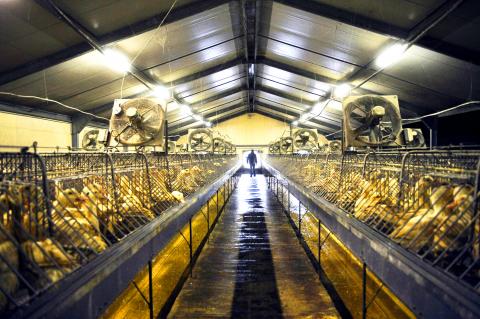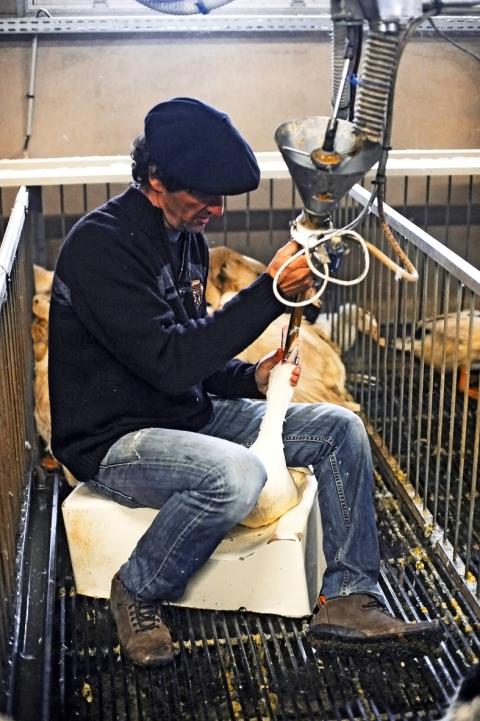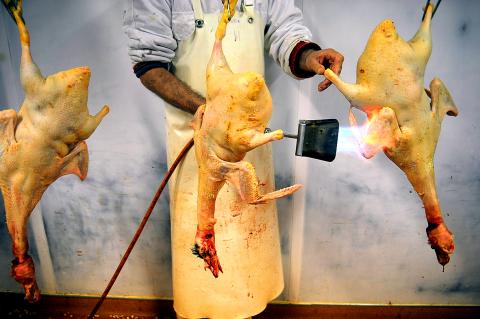Long accused of torture by animal rights activists, French foie gras producers are starting to admit that they may have gone too far and are vowing to change how ducks and geese are reared, and how their livers are fattened.
They are also promising a new spirit of openness and transparency about the controversial practice of gavage — the force-feeding of animals by passing plastic tubes through their throats directly into their stomachs.
“Maybe we did go a little too far,” said Marie Pierre Pe of CIFOG, an industry group representing French foie gras producers.

Photo: AFP
“In the [19]80s, 30 to 35 percent of foie gras came from Eastern European countries. We had to improve production to be more competitive and maybe went too far,” she said.
Animal rights activists have carried out a sustained campaign against foie gras — which means “fatty liver” in French — for decades.
Its sale has been banned in California, Britain’s House of Lords has taken it off its menu and Internet retailer Amazon.com Inc has banned it from its Web site.

Photo: AFP
The delicacy — a standard feature on French tables at Christmas and other festive occasions — is fiercely defended by fans who argue that birds stuff themselves with food in the wild while undertaking long migratory voyages.
Yet critics insist the practice is cruel and a 1998 EU report showed that death rates among force-fed birds could be up to 20 times higher than in those reared normally.
Foie gras producers have also come under fire for keeping the ducks and geese in cages where they have no space to move or even spread their wings.

Photo: AFP
France — which accounts for 75 percent of global foie gras production — widely adopted the practice of keeping birds in cage-like boxes in the 1980s.
Now, steps are being taken to improve conditions, with the French Ministry of Agriculture ordering producers by 2016 to introduce cages capable of housing at least three birds and that are big enough for them to move around and spread their wings.
CIFOG is also opening the doors of farms to show how the animals are reared and fed.
“Of course, gavage is not very romantic and so we avoided talking about it, but now we are trying to explain it more and more,” Pe said.
As part of its transparency drive, CIFOG recently showcased a farm in the region of Gers run by Pierre Peres and his twin brother, Philippe, who force-feed nearly 9,000 ducks a year.
Considered an artisan farm, it is far from typical industrial production.
At the Peres farm, ducks are kept in enclosed areas, but are free to move around. Force-feeding is done individually, with feeders picking up the animals and placing them on their laps to insert a funnel in their throats.
At the start of the gavage period, which normally lasts 15 days, the ducks are fed 250g of maize. The quantity is slowly increased to 500g.
There are about 1,500 such artisan foie gras farms in France, but they are hardly the norm. The vast majority of producers, about 5,000, are industrial sites that are the main target of rights groups.
A visit to an industrial foie gras farm run by the Euralis agricultural cooperative reveals a different world altogether from the Peres farm.
A total of 1,000 ducks are force-fed there, bundled in tight cages housing three birds each.
The cages are raised to human height to make the task of feeding the birds easier for workers. The floor below is a stinking mess, with a flowing yellow river of droppings and duck fat.
In one cage, several animals are clearly injured and bleeding. In another, a duck lies dead.
Xavier Fernandez, a researcher at the Institute of Agronomical Research in the southern city of Toulouse, said the images can be “shocking,” but added that visitors should “distance themselves emotionally” from what they see.
“Force-feeding is no more shocking than any other method of animal husbandry,” he said. “The real question eventually is whether we should be rearing animals for human consumption at all.”
For most in France, there seems to be little doubt, even when it comes to foie gras. An Opinionway poll conducted late last month found that only 29 percent of the French refuse to buy foie gras for ethical reasons and that 55 percent want force-feeding to continue.

Semiconductor shares in China surged yesterday after Reuters reported the US had ordered chipmaking giant Taiwan Semiconductor Manufacturing Co (TSMC, 台積電) to halt shipments of advanced chips to Chinese customers, which investors believe could accelerate Beijing’s self-reliance efforts. TSMC yesterday started to suspend shipments of certain sophisticated chips to some Chinese clients after receiving a letter from the US Department of Commerce imposing export restrictions on those products, Reuters reported on Sunday, citing an unnamed source. The US imposed export restrictions on TSMC’s 7-nanometer or more advanced designs, Reuters reported. Investors figured that would encourage authorities to support China’s industry and bought shares

FLEXIBLE: Taiwan can develop its own ground station equipment, and has highly competitive manufacturers and suppliers with diversified production, the MOEA said The Ministry of Economic Affairs (MOEA) yesterday disputed reports that suppliers to US-based Space Exploration Technologies Corp (SpaceX) had been asked to move production out of Taiwan. Reuters had reported on Tuesday last week that Elon Musk-owned SpaceX had asked their manufacturers to produce outside of Taiwan given geopolitical risks and that at least one Taiwanese supplier had been pushed to relocate production to Vietnam. SpaceX’s requests place a renewed focus on the contentious relationship Musk has had with Taiwan, especially after he said last year that Taiwan is an “integral part” of China, sparking sharp criticism from Taiwanese authorities. The ministry said

US President Joe Biden’s administration is racing to complete CHIPS and Science Act agreements with companies such as Intel Corp and Samsung Electronics Co, aiming to shore up one of its signature initiatives before US president-elect Donald Trump enters the White House. The US Department of Commerce has allocated more than 90 percent of the US$39 billion in grants under the act, a landmark law enacted in 2022 designed to rebuild the domestic chip industry. However, the agency has only announced one binding agreement so far. The next two months would prove critical for more than 20 companies still in the process

CHANGING JAPAN: Nvidia-powered AI services over cellular networks ‘will result in an artificial intelligence grid that runs across Japan,’ Nvidia’s Jensen Huang said Softbank Group Corp would be the first to build a supercomputer with chips using Nvidia Corp’s new Blackwell design, a demonstration of the Japanese company’s ambitions to catch up on artificial intelligence (AI). The group’s telecom unit, Softbank Corp, plans to build Japan’s most powerful AI supercomputer to support local services, it said. That computer would be based on Nvidia’s DGX B200 product, which combines computer processors with so-called AI accelerator chips. A follow-up effort will feature Grace Blackwell, a more advanced version, the company said. The announcement indicates that Softbank Group, which until early 2019 owned 4.9 percent of Nvidia, has secured a